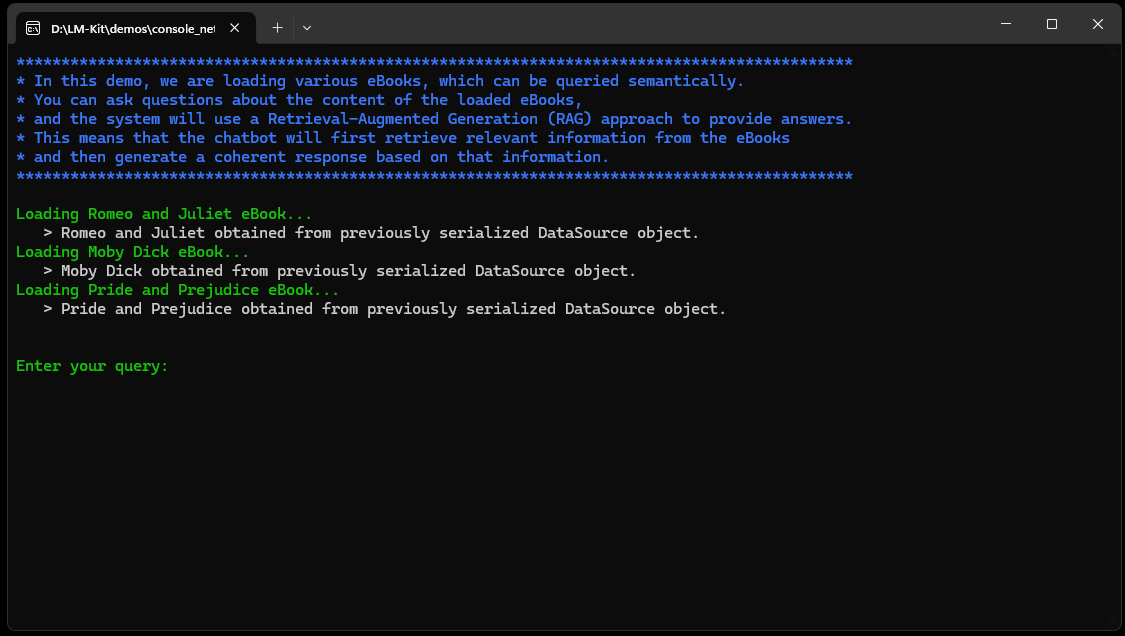RAG for Smarter .NET Applications
Turn Complex Data Retrieval into Accurate, Contextual Answers with LM-Kit’s C# RAG Engine
Elevate .NET Apps with Retrieval-Augmented Generation
Empower your C# and VB.NET solutions with contextually aware information retrieval through LM-Kit’s Retrieval-Augmented Generation (RAG) engine. By integrating on-device AI models and efficient similarity-based search, LM-Kit boosts the accuracy of data retrieval and provides highly relevant, context-driven responses. Whether you’re building knowledge-based chatbots, enhancing enterprise search tools, or creating advanced content discovery platforms, RAG helps you deliver faster, more accurate answers, all while keeping data private and secure on your own infrastructure.
Why RAG Matters for Modern .NET Applications
Contextual Understanding
Instead of returning generic or keyword-matched answers, LM-Kit’s RAG pinpoints the most relevant information by understanding semantics.
Reduced Hallucinations
Combining retrieval with generation decreases the risk of “hallucinated” responses, ensuring your AI outputs are grounded in real data.
Improved Scalability
Handle increasing data volumes without compromising performance, thanks to optimized chunking and embedding-based retrieval.
Privacy & Compliance
On-device inference keeps your data local, no need to send sensitive documents or user inputs to external servers.
Core RAG Components in LM-Kit
LM-Kit’s retrieval-augmented generation (RAG) relies on several modular classes to handle data ingestion, search, and context-aware response generation. These components can be combined or extended to build efficient RAG workflows for .NET applications.
RagEngine Class
The RagEngine manages retrieval and generation tasks by integrating text partitioning, similarity-based searching, and context creation. It supports both synchronous and asynchronous operations to accommodate different data sizes and use cases.
Key Features
Centralized Data Management
Handles multiple data sources in one place, making it easier to manage and query content from diverse repositories.
Flexible Search Workflows
Supports both synchronous and asynchronous similarity searches, allowing your application to balance performance and responsiveness.
Adaptive Import & Chunking
Dynamically partitions large texts through the TextChunking class, preserving context and reducing irrelevant data in retrieval.
Context-Driven Queries
Generates responses tied to relevant data partitions, ensuring queries are answered with information that’s both accurate and complete.
DataSource Class
The DataSource class serves as a central container for diverse content, including documents and web pages. It stores and organizes text in multiple sections, enabling efficient indexing, serialization, and retrieval.
Key Features
Unified Content Management
Provides a single interface for handling data from diverse sources, helping to reduce fragmentation and improve discoverability.
Robust Metadata Tracking
Stores essential metadata (e.g., identifiers, additional attributes), making it easier to locate, classify, and filter content.
Structured Hierarchical Storage
Organizes information into sections and text partitions, simplifying how you navigate and retrieve specific content segments.
Flexible Serialization & Cloning
Supports efficient storage, versioning, and sharing through binary serialization, while deep cloning prevents accidental cross-references in large datasets.
TextChunking Class
The TextChunking class partitions large text into smaller, coherent segments. Its recursive approach preserves semantic continuity at chunk boundaries, improving the accuracy and speed of text retrieval.
Key Features
Adaptive Partitioning
Recursively splits large texts into smaller, cohesive chunks based on complexity and structure, making extensive documents more manageable.
Structural Awareness
Suited for nested or hierarchical information, ensuring segmented data remains logically organized and easier to process.
Context Preservation
Uses adjustable overlap between consecutive chunks to maintain continuity, helping avoid loss of meaning at boundary points.
Optional Layout Retention
Offers the flexibility to preserve consecutive spaces and text formatting for scenarios where precise layout matters.
Embedder Class
The Embedder class creates high-dimensional vector representations for text or tokenized data, supporting tasks such as semantic search, classification, and clustering. It also provides methods for computing similarities between generated embeddings.
Key Features
High-Dimensional Representations
Transforms text into embedding vectors that capture semantic details, making advanced tasks like search, clustering, and classification more accurate.
Built-In Similarity Assessment
Includes cosine similarity measurements to compare embeddings, aiding in quickly ranking or grouping related content.
Streamlined Workflow
Offers synchronous and asynchronous methods for generating embeddings, helping applications handle data at scale without blocking operations.
Direct Model Integration
Leverages a specified LM for generating embeddings, ensuring consistent results across various NLP and coding-related tasks.
Streamlining Custom RAG Pipelines
Building a custom retrieval-augmented solution can be challenging, but LM-Kit simplifies the process with a rich set of high-level APIs and configurable modules:
Custom Chunking Strategies: Adjust chunk sizes, overlap thresholds, and partition rules based on data complexity.
Flexible Metadata Management: Tag your content with domain-specific metadata for more targeted retrieval.
Conversation Integration: Seamlessly link RAG with LM-Kit’s conversational modules to build chatbots that provide contextually grounded answers.
Adaptive Embedding Models: Plug in your preferred embedding model to match the languages, domains, or performance levels you require.
Multi-Step Query Handling: Combine multiple queries or user prompts into a single pipeline, enabling sophisticated retrieval scenarios.
Benefits of LM-Kit RAG
Enhanced User Experiences
Deliver precise answers to user queries, reducing the need to sift through irrelevant search results.
Scalable Knowledge Management
Index diverse data sources and handle complex retrieval tasks with minimal overhead.
On-Device Security
Process all information locally, maintaining compliance with data protection regulations.
Accelerated Development
Cut down on integration time with ready-to-use classes, robust documentation, and sample code.
Flexible Customization
Tailor every aspect of the RAG pipeline – from chunking logic to embedding models – to align with your unique use cases.
Example Use Cases
Enterprise Knowledge Base
Help employees find relevant documentation, reports, and policies quickly, complete with context-based answers.
Customer Support Chatbots
Enable your virtual agents to provide accurate solutions to user issues by retrieving the right information in real time.
Academic & Research Tools
Source references and citations from vast libraries of research papers, delivering deeper insights for students and professionals.
Legal Document Processing
Retrieve specific clauses or precedent cases from extensive legal databases, ensuring grounded, compliant responses.
Real-Time GenAI RAG Chatbot Demo
The Real-Time GenAI RAG Chatbot Demo showcases the use of the LM-Kit.NET SDK to develop a chatbot powered by Retrieval-Augmented Generation (RAG) techniques. This demo highlights how to integrate large language models into a .NET application, enabling the chatbot to fetch pertinent information from predefined data sources and generate meaningful, contextually accurate responses.
Get Started with LM-Kit RAG
1 - Download from NuGet
Add the LM-Kit.NET SDK to your .NET project for immediate access to the RagEngine and related classes.
2 - Explore the Documentation
Visit the RagEngine Class Documentation to learn about each method, parameter, and best practice for building robust pipelines.
3 - Try the Demo Repository
Clone our example projects and tutorials to see the full potential of RAG in action.
4 - Customize & Deploy
Fine-tune your RAG pipeline to meet specific domain or compliance requirements and roll out your new AI-powered features.
Ready to Transform Your Data Retrieval?
LM-Kit’s Retrieval-Augmented Generation engine brings advanced, context-aware information retrieval directly to your .NET applications, no cloud dependencies required. Experience faster time-to-market, better user satisfaction, and airtight data security with our on-device AI approach.
Get Started Today
Have questions or need more information? Contact Us to discover how LM-Kit can supercharge your RAG implementation for .NET.

